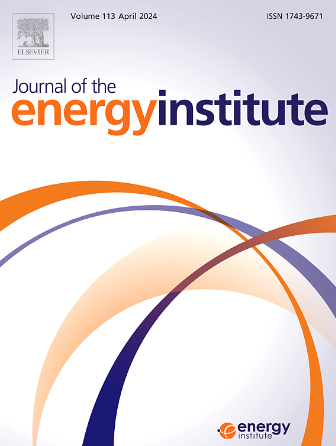基于温和酸预处理工艺研究的污泥与生物质组分热解强化生物燃料生产的相互作用
IF 6.2
2区 工程技术
Q2 ENERGY & FUELS
引用次数: 0
摘要
污水污泥(SS)和稻草(RS)作为一种潜在的有价值的资源,正被研究用于在固定床反应器中通过热解生产生物燃料。本研究在固定温度下,对污泥和稻草及其处理变化进行了共热解。为了评价酸预处理对SS和RS的影响,对产物产率和表征研究进行了评估。原料SS或处理过的污泥(TSS)与原料RS或处理过的稻草(TRS)共热解对生物燃料产率的分布和组成有不同的影响。RS单独热解产油量比SS高47.4 wt%,而TRS和TSS热解产油量最高,分别为54.3%和40.6 wt%。在共热解工况下,TRS + TSS组合热解油、焦、气的产率最高,分别为47.7 wt%、42.0%和10.3 wt%。在本研究中,SS + RS对产油的协同程度最低,TSS + TRS对产油的协同程度最大。SS的预处理效果优于炭产率,使炭产率降低了11.8%,产生的生物炭的最大热值为16.02 MJ/kg。与其他组合相比,由TRS获得的焦炭具有更高的热值,为22.77 MJ/kg。此外,预处理和共热解对热解油的含量有影响,使热值提高到18.01 MJ/kg。热解油的色谱分析结果表明,预处理工艺提高了苯酚、呋喃和其他芳香烃的收率。最后,共热解与预处理相结合影响了热解气体剖面,改变了氢(H2)、甲烷(CH4)、一氧化碳(CO)、二氧化碳(CO2)和乙烷(C2H6)等气体馏分的产率。本文章由计算机程序翻译,如有差异,请以英文原文为准。

Interaction between sewage sludge and biomass components for enhanced biofuel production via pyrolysis based on studies of the mild acid pre-treatment process
Sewage sludge (SS) and rice straw (RS) are being investigated as a potential valuable resource for the production of biofuel through pyrolysis in a fixed bed reactor. Sewage sludge and rice straw, along with their treated variations, were co-pyrolyzed in this study under fixed temperature. The product yields and characterization study were assessed in order to evaluate the impact of acid pre-treatment of SS and RS. The distribution and composition of the biofuel yields were affected differently by the co-pyrolysis of raw SS or treated sewage sludge (TSS) with either raw RS or treated rice straw (TRS). Individual pyrolysis of RS produced maximum pyrolysis oil of 47.4 wt% than the pyrolysis of SS. On the other hand, pyrolysis of TRS and TSS produced the maximum oil yield of 54.3 wt% and 40.6 wt%, respectively. Under co-pyrolysis operation, the combination of TRS + TSS produced the maximum pyrolysis oil, char, and gas yield of 47.7 wt%, 42.0 wt%, and 10.3 wt%, respectively. In this study, the degree of synergy on oil yield was lowest in SS + RS and maximum in TSS + TRS. Pre-treatment of SS outperformed the production of char yield, where it reduced the yield of char by up to 11.8 % and produced biochar with a maximum heating value of 16.02 MJ/kg. Compared to other combinations, the char obtained from TRS has a higher heating value of 22.77 MJ/kg. Additionally, pre-treatment and co-pyrolysis affected the contents of pyrolysis oils, raising the heating value to 18.01 MJ/kg. The chromatographic analysis of the pyrolysis oil results shows that the pre-treatment process increased the yield of phenols, furans, and other aromatic hydrocarbons. At last, the co-pyrolysis in combination with pre-treatment affected the pyrolysis gas profile, altering the yield of various gas fractions such as hydrogen (H2), methane (CH4), carbon monoxide (CO), carbon dioxide (CO2), and ethane (C2H6).
求助全文
通过发布文献求助,成功后即可免费获取论文全文。
去求助
来源期刊

Journal of The Energy Institute
工程技术-能源与燃料
CiteScore
10.60
自引率
5.30%
发文量
166
审稿时长
16 days
期刊介绍:
The Journal of the Energy Institute provides peer reviewed coverage of original high quality research on energy, engineering and technology.The coverage is broad and the main areas of interest include:
Combustion engineering and associated technologies; process heating; power generation; engines and propulsion; emissions and environmental pollution control; clean coal technologies; carbon abatement technologies
Emissions and environmental pollution control; safety and hazards;
Clean coal technologies; carbon abatement technologies, including carbon capture and storage, CCS;
Petroleum engineering and fuel quality, including storage and transport
Alternative energy sources; biomass utilisation and biomass conversion technologies; energy from waste, incineration and recycling
Energy conversion, energy recovery and energy efficiency; space heating, fuel cells, heat pumps and cooling systems
Energy storage
The journal''s coverage reflects changes in energy technology that result from the transition to more efficient energy production and end use together with reduced carbon emission.
 求助内容:
求助内容: 应助结果提醒方式:
应助结果提醒方式:


